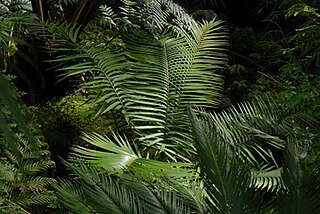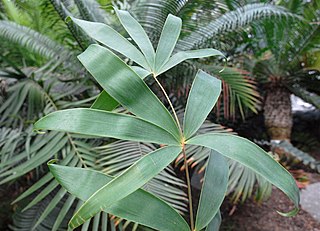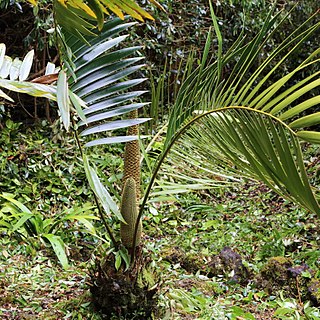
The Zamiaceae are a family of cycads that are superficially palm or fern-like. They are divided into two subfamilies with eight genera and about 150 species in the tropical and subtropical regions of Africa, Australia and North and South America.

Ceratozamia is a genus of New World cycads in the family Zamiaceae. The genus contains 27 known currently living species and one or two fossil species. Most species are endemic to mountainous areas of Mexico, while few species extend into the mountains of Guatemala, Honduras and Belize. The genus name comes from the Greek ceras, meaning horn, which refers to the paired, spreading horny projections on the male and female sporophylls of all species.

Ceratozamia hildae, commonly known as the bamboo cycad, is a species of cycad in the family Zamiaceae that is endemic to Mexico. It is native to the Huasteca Potosina of Querétaro and San Luis Potosí, near the Santa Maria River. C. hildae inhabits deciduous oak woodlands at elevations of 850–1,300 m (2,790–4,270 ft). It is threatened by habitat loss and over-collecting.

Ceratozamia kuesteriana is a species of cycad in the family Zamiaceae that is endemic to the Sierra Madre Oriental of Mexico.

Ceratozamia latifolia is a species of cycad in the family Zamiaceae that is endemic to Querétaro, Hidalgo and San Luis Potosí in Mexico. It inhabits cloud zone oak forests in the Sierra Madre Oriental.

Ceratozamia mexicana is a species of plant in the family Zamiaceae.

Ceratozamia microstrobila is a species of plant in the family Zamiaceae.
Ceratozamia morettii is a species of plant in the family Zamiaceae. It is endemic to Mexico, where it is limited to the state of Veracruz north of Jalapa. It grows on steep clay and basalt cliffs in cloud forest habitat.

Ceratozamia sabatoi is a species of plant in the family Zamiaceae. It is endemic to Mexico, where it occurs in the states of Hidalgo and Querétaro. It is known from only two localities, one of which is degraded by agriculture and grazing.
Ceratozamia whitelockiana is a species of plant in the family Zamiaceae. It is endemic to Mexico, where it is known only from Metates and Chiapan in Oaxaca state. Only two subpopulations have been found, with a total population of about 2200 individuals. The habitat is threatened by conversion to plantations using slash-and-burn techniques.
Loran M. Whitelock was an American botanist who specialized in Cycads, a prehistoric plant that once dominated the planet and is now somewhat rare and endangered. He was known as a plant collector, plant curator, nursery owner, author, and conservationist. He was instrumental in promoting cycads as a garden feature in Southern California through his nursery and other contributions. Several plants were named in his honor including Encephalartos whitelockii and Ceratozamia whitelockiana.
Ceratozamia hondurensis is a species of cycad in the family Zamiaceae.
Ceratozamia brevifrons is a species of cycad in the family Zamiaceae.
Ceratozamia chimalapensis is a species of cycad in the family Zamiaceae. It is found in the extreme western portion of the Sierra Madre de Chiapas massif.
Ceratozamia decumbens is a species of cycad in the family Zamiaceae.
Ceratozamia mirandae is a species of cycad in the family Zamiaceae endemic to Chiapas and Oaxaca, Mexico. It is found on the slopes of the Sierra Madre de Chiapas and Sierra de Niltepec, near La Tigria.
Ceratozamia santillanii is a species of cycad in the family Zamiaceae.
Ceratozamia vovidesii is a species of cycad in the family Zamiaceae endemic to the Sierra Madre de Chiapas of Mexico.
Ceratozamia zoquorum is a species of cycad in the family Zamiaceae endemic to northwestern Chiapas, Mexico.






